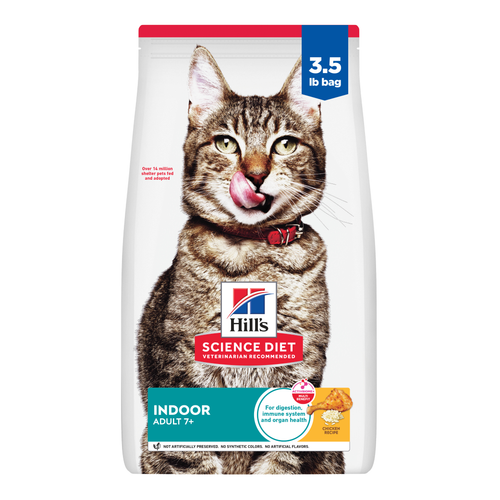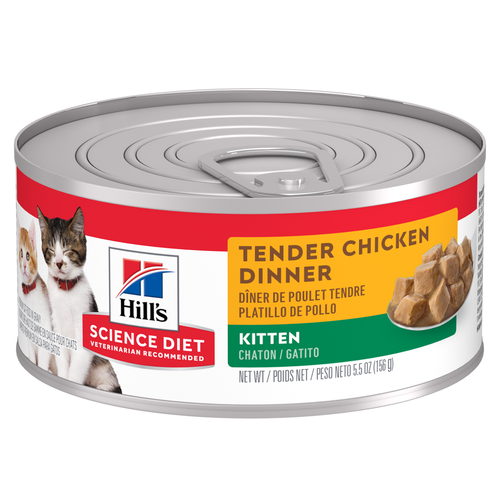
-
Find the right food for your petTake this quiz to see which food may be the best for your furry friend.Find the right food for your petTake this quiz to see which food may be the best for your furry friend.Featured products
 Adult Sensitive Stomach & Sensitive Skin Variety Pack Pouches (Chicken Stew & Turkey Stew)
Adult Sensitive Stomach & Sensitive Skin Variety Pack Pouches (Chicken Stew & Turkey Stew)Supports digestive health, nourishes skin and promotes a lustrous coat
Shop Now Adult Small Bites Chicken & Barley Recipe Dog Food
Adult Small Bites Chicken & Barley Recipe Dog FoodSupports lean muscle for dogs who prefer smaller kibble
Shop Now Adult 7+ Senior Vitality Chicken & Vegetable Stew Dog Food
Adult 7+ Senior Vitality Chicken & Vegetable Stew Dog FoodNutrition that helps a senior dog's everyday ability to get up and go
Shop NowFeatured products Adult Turkey & Liver Entrée Cat Food
Adult Turkey & Liver Entrée Cat FoodPrecisely balanced nutrition with the delicious taste of minced turkey & liver to help fuel the energy needs of cats during the prime of their life
Shop Now Adult 7+ Indoor Chicken Recipe Cat Food
Adult 7+ Indoor Chicken Recipe Cat FoodSupports energy level and beautiful fur in mature indoor cats
Shop Now Senior Vitality Adult 7+ Tuna & Vegetables Stew
Senior Vitality Adult 7+ Tuna & Vegetables StewImproves Everyday Ability to Get Up & Go
Shop Now -
Dog
- Dog Tips & Articles
-
Health Category
- Weight
- Food & Environmental Sensitivities
- Urinary
- Digestive
- Joint
- Kidney
-
Life Stage
- Puppy Nutrition
- Adult Nutrition
- Senior Nutrition
Cat- Cat Tips & Articles
-
Health Category
- Weight
- Skin & Food Sensitivities
- Urinary
- Digestive
- Kidney
-
Life Stage
- Kitten Nutrition
- Adult Nutrition
Featured articles What Is Littermate Syndrome? Pet Adoption Guide
What Is Littermate Syndrome? Pet Adoption GuideLearn more about littermate syndrome in dogs and cats and how to successfully navigate adoption and early socialization processes.
Read More The Science Behind Our Love for Pets
The Science Behind Our Love for PetsLearn the scientific reasons why we have such strong connections with our pets, and what science says about the love between humans and our furry friends.
Read More How to Properly Mix Wet & Dry Pet Foods
How to Properly Mix Wet & Dry Pet FoodsAn Orange cat eating from a bowl filled with mixed food
Read More -


Although there are government regulations on what labels can tell you about what's in cat food, knowing how to read pet food labels and find the information you're looking for can still be a challenge for both new and seasoned pet owners. Knowing a little bit about the things you see on cat food labels can help you make an informed decision on which food you should purchase for your feline friend.
Sorting Through Certifications and Special Labeling
Learning how to read pet food labels begins with learning what to focus on. Don't let catchy phrases or special seals of approval distract you. The Food and Drug Administration (FDA) takes the lead in the United States on pet food label requirements, and allows state Departments of Agriculture add requirements as they see fit. According to the FDA website, "current FDA regulations require proper identification of the product, net quantity statement, name and place of business of the manufacturer or distributor, and proper listing of all the ingredients in the product in order from most to least, based on weight." Although the FDA has some guidance on what should and should not be in pet food, your vet should be guiding you on what ingredients and nutrients your individual pet needs, and can tell you what to look for on pet labels that may be specific to your cat's age, environment, lifestyle or breed.
AAFCO (Association of Animal Feed Control Officials), CVM (the FDA's Center for Veterinary Medicine), and the USDA (United States Department of Agriculture) are other acronyms you may see on pet food packaging. All of these organizations put time and resources into pet food research, but a seal from one of these groups does not mean that is the best cat food on the market or the best food for your kitty.
As an informed consumer, you should also watch for pet food recalls. All manufacturers may have a recall here and there, but if a particular brand is having repeated and frequent problems, it may be a company to stay away from. Also, pay attention to who announces the recall—whether it was released by the FDA or by the food brand itself. Some cat foods might be recalled as a precaution and not from a serious threat, so always read alerts closely before making a decision to boycott a certain brand.


Tasty Tips
Ingredients vs. Nutrients: What to Look For on a Label
Reading ingredients might seem straightforward, but are ingredients and nutrients the same thing? For both you and your cat, the answer is no. You can think of ingredients as the way nutrients are transported. For example, if lamb is listed on a can or bag, you know that meat contains nutrients such as protein, fatty acids, and vitamins. Ingredients on cat food labels are listed from heaviest to the lightest by weight. This is important to know since many meats (such as chicken) have water weight and are heavier than vegetables or grains. Just because peas and carrots are listed last doesn't mean that the food contains only a small proportion of them.
Talk to your vet about the most essential nutrients and recommended ingredients for your cat. Protein and fat are legally required to be listed on pet foods in some form, however, vitamins and minerals are often not listed on labels, so you'll have to educate yourself on which ingredients have nutrients your pet needs. Knowing how to read pet food labels will help you identify what is and what isn't in your cat's meals.
Buzz about high-protein and meat-only diets can send some pet parents running to the store looking for cat food with lots of meat. Although many meats provide vital nutrition for your cat, having meat listed as the first ingredient doesn't always mean that food is the best choice for your cat. Unless your vet tells you that your pet needs a high protein diet, more protein may not be a good thing. Rather, just like any ingredient or nutrient, it should be properly balanced in the right proportions that makes the most sense for your cat.
The best cat food recipes are ones that give a full balance of nutrients. Although many types of foods have protein, including meats, eggs, and legumes, protein from meat ingredients contains the amino acid taurine. Taurine is a critical nutrient for cats, and can't be transported through plant-based protein ingredients. Your animal also needs other nutrients besides protein to stay healthy. The best cat foods have a mix of protein, fats (chicken fat, oil, etc.) and vitamins (such as A, C, and E). Some carbohydrates like barley, oats, rice, wheat, corn, and potatoes show up in cat foods that help give your kitty the energy she needs to stay playful.
If there are other ingredients on your cat food's label that you don't fully understand, or they don't seem like a natural ingredient, make sure to talk to your vet to understand whether they are necessary ingredients. While natural ingredients seem like they'd be the best option for your cat, some nutrients that your cat's health will benefit from that aren't as prevalent in the main ingredients you're used to seeing listed on a cat food label. For instance, Science Diet® adds in vitamins, minerals and amino acids that benefit your cat's healthy development. So, while it is made with many natural ingredients you're used to seeing, you might also come across some ingredients like Pyridoxine Hydrochloride (a version of Vitamin B that supports amino acid synthesis). Know that they may just be scientific sounding words that actually are very important for your cat's health. This is why your vet is a great source of information because they can help you understand what each ingredient's role plays in your kitty's health.
Picking the Right Food for Your Cat
Once you look at a few different labels, talk to your vet and get their thoughts. Outside of you, your vet will know your cat best and they can provide their own recommendations based on your cat's specific needs. You might start off buying a small amount of the cat food to make sure your cat likes it. While many cats will love the taste of one food, some cats can be finicky (just like children) and not take to it. Also, make sure to transition her to the new food over a period of time, so as to not upset her digestion.
Finally, a healthy cat food is food that you and your vet agree meets the nutritional needs of your individual pet. Just because you've fed one cat a particular food for years doesn't mean it's the best choice for a new pet. Over time, some cats develop additional nutritional needs based on their age, lifestyle, or genetics, and may require a therapeutic cat food. Regular vet checkups and frequent monitoring of what your cat is eating and how she is behaving are part of being a responsible cat parent, as is knowing how to read pet food labels. Now that you better understand what you're looking at, the next time you read a cat food label you should be able to make an informed purchase decision. If you ever have specific questions about any of Hill's® pet foods, you can also contact us or start a chat with us, available in the navigation of HillsPet.com


Chrissie Klinger is an educator, writer and mother of two children, three dogs and three cats. Her dog Jake loves sitting on her lap every chance he gets! She enjoys living an active and eco-friendly lifestyle in rural Pennsylvania.
Related products

Precisely balanced nutrition with the delicious taste of minced turkey & liver to help fuel the energy needs of cats during the prime of their life

Improves Everyday Ability to Get Up & Go

Supports energy level and beautiful fur in mature indoor cats

Delectable chunks with tender chicken smothered in a rich gravy
Related articles

Learn how to litter train a kitten with this guide to potty training, including when to start litter training kittens and troubleshooting tips.

Discover how to train your cat, starting with very basic first steps that both reward good behavior and discourage the bad.

Discover which cat toys games your feline friend might like, and how they are great sources of exercise. Explore our library of articles to learn more.

When you adopt a cat, you don't just gain a best friend; you also save her life. Here's why getting a cat from a local animal shelter makes so much sense.

Put your cat on a diet without them knowing
Our low calorie formula helps you control your cat's weight. It's packed with high-quality protein for building lean muscles, and made with purposeful ingredients for a flavorful, nutritious meal. Clinically proven antioxidants, Vitamin C+E, help promote a healthy immune system.
Put your cat on a diet without them knowing
Our low calorie formula helps you control your cat's weight. It's packed with high-quality protein for building lean muscles, and made with purposeful ingredients for a flavorful, nutritious meal. Clinically proven antioxidants, Vitamin C+E, help promote a healthy immune system.


